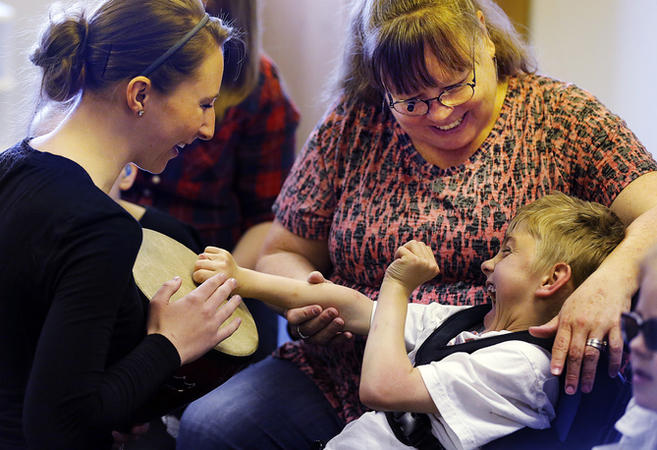Music Therapy in Special Education: Utah Schools for the Deaf and Blind
We were recently featured on KSL and in the Deseret News for our work with students at the Utah Schools for the Deaf and Blind. Music Therapy is so powerful in special education–here’s why.
Click here for the Original Article in the Deseret News
Click here for the KSL Story
Photo credit to Ravell Call, Deseret News
MILLCREEK — Rachel Lighty sings a “hello” song and plays her guitar for a captive audience with special challenges. She loves her job helping children who can’t see or hear better interact with the world around them.
“It is so rewarding to me on so many levels,” said Lighty, a licensed music therapist. “I get to see these kids progress in their goals and get to see them come out of their shells and see their personalities blossom — it’s so cool. It’s the coolest thing ever.”
Kids like Kameron sing enthusiastically. “It’s good to jam out even if you’re young or old, big or small,” he said. “It’s good to jam out.”
And Emory, who wears a large bow on her long, blond ponytail. “I always like to sing,” she said.
Lighty has seen steady progress in each of her students, including Emory. “Before she just wouldn’t really say what she wanted to do or give an opinion, but now she’s really come out of that shell,” she said.
Lighty belts out the lyrics, “Make a little music with your friends,” as the students sing along as much as they can. At the Millcreek campus of the Utah Schools for the Deaf and Blind, they celebrate each accomplishment and reach high for new goals.
Lighty plays the guitar over her head and encourages the students to do the same with the drums, tambourines and other instruments she passed out earlier. Through music, rhythm and vibration, and by taking turns, kids learn things they can take back to the classroom.
“Communication skills, cognitive skills, social skills, all those other things you don’t really think about,” Lighty said.
Charlie can’t speak but communicates by squeezing a person’s right hand for “yes” and the left for “no.” When asked if the music makes him feel happy, he answers, “Yes.”
Lighty has been working with these students since the first of the year. She knows their strengths and works with their abilities. Some of them can hear a little, some of them can see a little, but they always make sure they have fun — no matter how severe their disability.
“So he had a target and he touched it,” Lighty said after a child reached out to strum the guitar. “He did need some help along the way, but he touched it and that’s progress.”
Ellie loves to sing songs that inspire her. “Being brave and strong and flexing your muscles like superheroes — they flex their muscles before they save people’s lives,” she said.
After all, superheroes come in all shapes and sizes. Some wear fur, like the teddy bear perched on the classroom shelf wearing a Superman T-shirt. Some wear glasses, like Lighty’s grandfather, who lost his ability to talk. Through music, he could communicate and speak, even when all else was gone. It’s what inspired Lighty to become a music therapist.
Lighty ends by singing a “goodbye” song to the children.
Yes, heroes come in all shapes and sizes. Some even wear a guitar.

